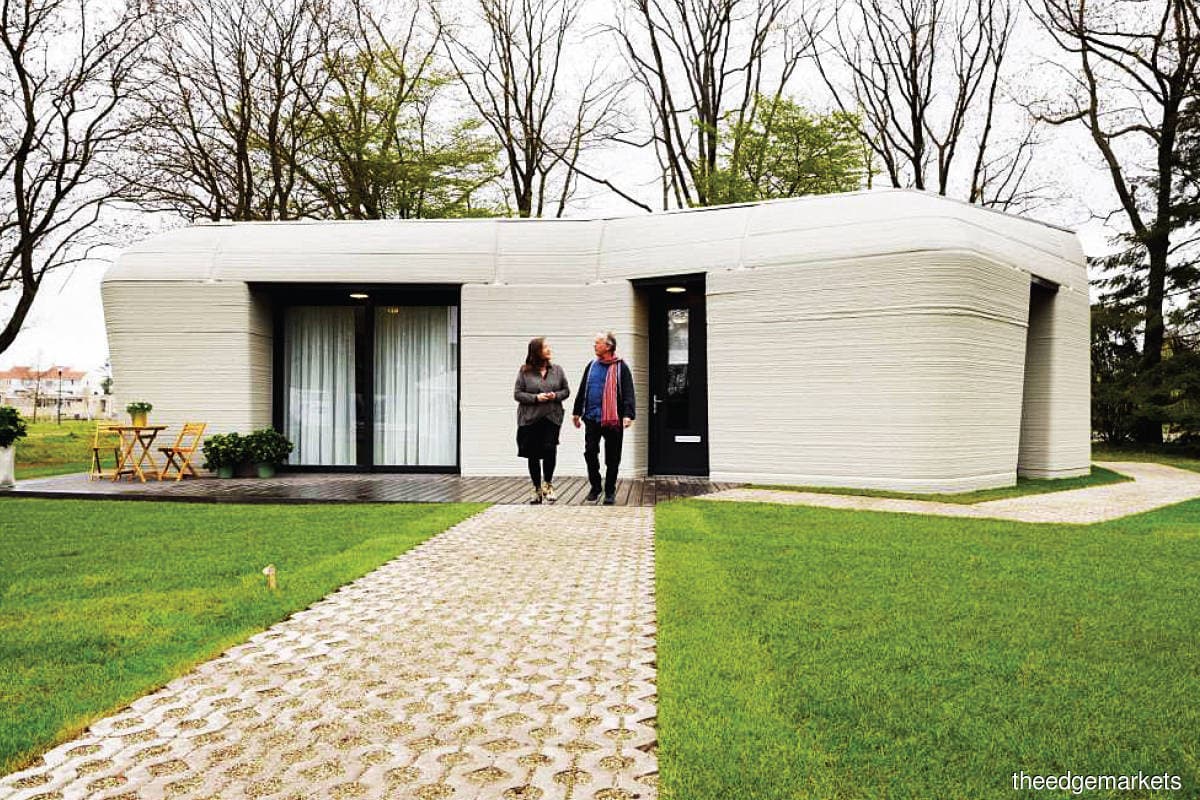This article first appeared in Digital Edge, The Edge Malaysia Weekly on November 15, 2021 - November 21, 2021
When Covid-19 first hit Malaysia in March last year, there was a scramble for personal protective equipment (PPE) such as face shields and the protective suits that frontliners wear.
It was not just a local shortage. Similar situations were observed in other countries, so importing supplies was not the solution.
At this time, Ahmad Nurfaiz, a user interface and user experience (UI/UX) designer, was following social media posts by makers in Europe who were using their 3D printers at home to produce PPEs. As a fan of the maker movement and a hobbyist himself, this activity piqued his interest.
One day, his wife, a doctor at a public hospital, came home and told him that the situation was getting worse. He also saw viral videos on social media that showed healthcare personnel in hospitals wearing plastic bags and makeshift face shields.
Nurfaiz felt moved to do something. So, he created a Facebook post to ask for help. “Hey, I’m a maker and I can make face shields at home using my 3D printer. I’m calling all makers out there who have printers at home: Let’s band together and try to supply face shields!”
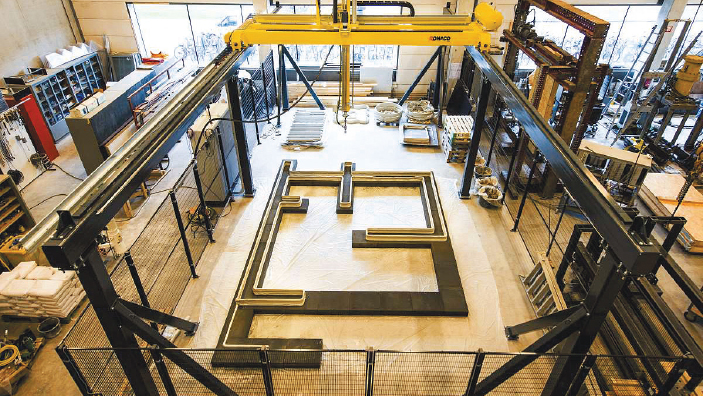
The process of 3D printing a house in the Netherlands
The post went viral, many people contacted him and, soon, he had a Facebook group with almost 5,000 members.
They immediately set to work to produce face shields, which they determined was easiest to produce at the time. Using an open-source design, they started printing the frame that holds the plastic shield.
“The first week was quite hectic. Some volunteers who were good at using spreadsheets helped us come up with a supply-and-demand table. We divided our volunteers into groups, based on which state they lived in,” says Nurfaiz.
Eventually, they printed up to 150,000 face shields and distributed them to hospitals. They also roped in industry players to use their designs and mass-produce face shields in factories.
This bottom-up, heroic story of makers in Malaysia is not the only one. Many others were also organising separate movements to address the crisis — and not only in the Klang Valley. “We are decentralised. If you live in East Malaysia, we can send the design to you and you can print it there,” says Wan Cheng Huat, who is part of another maker community.
The creativity and agility of these makers are testament to the potential of 3D printing in Malaysia. Given the talent and passion of these makers, the impact of 3D printing could also be extended beyond the pandemic.
What’s the deal with 3D printing?
Also known as additive manufacturing, 3D printing was invented in the 1980s but its adoption by the masses properly began in 2009, when the patent for Fused Deposition Modelling (FDM) printers expired.
Since then, prices of FDM printers have fallen from more than US$10,000 to less than US$1,000, according to Tech Crunch. Home 3D printers emerged in 2010, according to Deloitte.
“3D printers used to cost around RM15,000. Now, I can get it for below RM1,000. The materials used to be around RM250 per kg, but now it can go as low as RM30 per kg,” says Kevin Lim, lead engineer of 3D printing company Kon10 Enterprise.
The improvement of the software interface and availability of open-source designs also spurred the growth of 3D printing.
“As more people began to use it, they troubleshot the problems and shared their solutions on YouTube. That’s how we learn,” says Lim.
There are a few types of 3D printing technology (see “Most established types of 3D printing”). In general, 3D printing adds materials layer by layer to create a product, based on digital designs. This is in contrast with conventional methods of using a machine to cut or drill parts out of a block of metal, for instance, or injecting raw material into moulds.
3D printing can use plastic resin, powders, metal and many other materials. It is used for rapid prototyping because you can create custom designs relatively quickly and cost effectively.
“It saves the number of iterations needed to build one finalised product. Right now, manufacturers carve the negative shape of a product into a mould, inject plastic and then check the end-product. The dimensions are never accurate on the first go,” says Lim.
The moulds have to be made with computer numerical control (CNC) machines and each iteration could be costly. “If you use 3D printing to create the prototype, the cost is maybe 30% of what it would otherwise be. It saves time, and you can make changes easily on the computer.”
It results in less waste, since you print only what you need, according to a Deloitte report on additive manufacturing. Compared with conventional methods, 3D printing can be used to create more complex and compact designs. It can also be done with fewer part counts.
On a related note, mass customisation is possible with 3D printing, as adjustments can be done digitally.
But, of course, there are limitations. The Deloitte report highlights technical challenges as a major hurdle, which is why 3D printing is still used mainly for prototyping at this stage. The standardisation and qualification of materials, reliability and high cost of the technology are other challenges. How manufacturers can integrate this technology into their lines will have to be explored.

The first 3D-printed steel bridge in Amsterdam
How is 3D printing being used?
Many interesting applications of 3D printing are observed in the aerospace industry.
A joint venture involving Airbus Group is using 3D printing to manufacture the injector head of the Ariane 6 launcher. Injector heads are typically made from hundreds of parts that need to be welded together. But 3D printing enables these components to be manufactured in a single piece, thus reducing production time and reducing cost by 50%, according to AMFG, provider of automation software for industrial 3D printing.
Meanwhile, NASA sent the first 3D printer to space in 2014 so that scientists onboard could use it to manufacture tools.
The construction industry is another space with potential. Companies are excited about the possibility of 3D printing, as it will enable the mass production of customised buildings that can be completed in a shorter span of time with high levels of accuracy and less reliance on human labour. It is being explored as a solution to the declining construction workforce and to reduce waste.
In April, tenants moved into Europe’s first fully 3D-printed houses in Amsterdam. A nozzle from a huge robotic arm poured out specially formulated cement and printed the building according to the architect’s design, layer by layer. It took 120 hours to complete the printing process.
The first 3D-printed steel bridge also debuted in Amsterdam in July this year. It combines the skills of traditional steelwork and advanced digital modelling, according to Arup, the lead structural engineering firm for the project.
3D printing in this sector is considered an emerging technology, however, and the functionality of these structures is being tested.
Automotive companies have also been actively dabbling in this technology. BMW, Porsche and Ford Motor Co use 3D printing for prototyping, to build tooling aids for manufacturing and assembly, and to mass-manufacture metal fixtures, according to AMFG. These companies cited lower costs and weight reduction as key benefits of using this technology.
In the medical field, 3D printing is used to make dental devices that straighten and adjust teeth. It is also used to produce customised prosthetics and orthopaedic devices
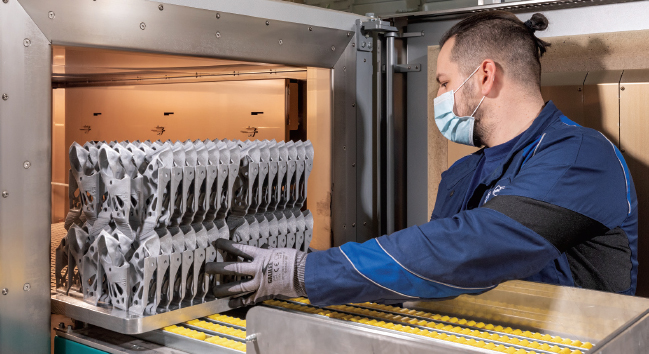
BMW 3D print metal parts for Rolls Royce
Most established types of 3D printing
Stereolithography (SLA)
The world’s first 3D printing technology, it uses a laser to turn liquid resin into hardened plastic, layer by layer. The laser traces a different pattern for each layer to form the shape of the 3D object. This is useful for prototyping, modelling and short-run production.
Selective laser sintering (SLS)
The technology is similar to SLA, but uses powdered material placed in layers. The material is sintered by laser according to the pattern of the object to be built. It is ideal for building complex geometries and its strength can resemble that of injection-moulded parts, making it a popular choice for functional prototyping, according to Formlabs, a 3D printing technology developer and manufacturer in the US.
Fused Deposition Modelling (FDM)
This is the most widely used type of 3D printing among consumers. It melts thermoplastic filament and builds the structure layer by layer. It is suitable for modelling and low-cost prototyping of simple parts. It has less resolution and accuracy than the other two, says Formlabs.
3D printers in the fight against Covid-19
The 3D printing communities that came together during the pandemic were eager to put their printers to use. They brainstormed what equipment they could print to help the frontliners.
Face shields were the easiest, but there were also groups looking into other equipment. “We were also working on building aero chambers. This is typically used by children who have asthma and cannot use inhalers properly yet. Instead, medication is sprayed into the aero chamber and the child can breathe in the medication through the device at their own pace,” says Wan Cheng Huat, a maker leading one of the movements.
“The equipment costs RM150 to RM200, but we managed to print it for below RM10. The designs are available online.”
Ahmad Nurfaiz, another movement leader, says there were also teams that printed ventilators. “They used a schematic, which is an open-source design, from the 1970s,” he says. “Some people in the group tried to procure diving masks [and turn these into breathing aid devices] for patients to breathe easily without intubation.”
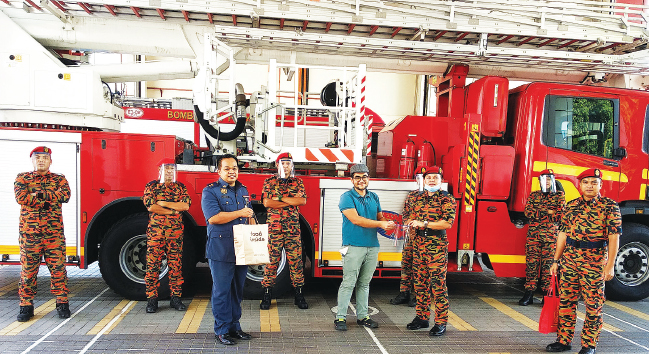
Nurfaiz handing over 3D-printed face shields (inset) to the firefighting department
Wan and Nurfaiz say these products were not used by frontliners, however, because there was no shortage of ventilators or the other equipment last year. In addition, medical devices are under strict regulations, for obvious reasons.
Doctors were wary about using these devices since they had not been tested, and they were unsure of the conditions in which they were manufactured. For safety reasons, medical devices have to be manufactured in controlled environments to prevent contamination.
The communities did not start up their printers this year because there was less of a shortage of PPEs, Wan and Nurfaiz say, and the ventilator shortage was not something they could help with. “Ventilators require intubation and it’s used in critical, end-of-life situations. The machine cannot fail. That’s why we will not get approval to use this type of DIY machines,” says Wan.
Similar challenges were observed in the US. Interestingly, the Food and Drug Administration (FDA) published a report assessing the role of additive manufacturing in response to Covid-19 last year. 3D-printing communities in the US made face shields, ear savers (for face masks) and nasal swabs for hospitals.
Doctors were not confident about using non-FDA-approved equipment, but thanks to the Covid 3D Trust (a collaboration between a few health-related government administrations and the US maker community) and the National Institute of Health’s 3D Print Exchange, some designs were found appropriate for emergency use in clinical settings when fabricated with specific printers and materials.
Owing to the dire situations, some Spanish hospitals approved the use of 3D-printed ventilators during the pandemic last year. Similarly, at least two hospitals in Italy began using 3D-printed respirator valves. The European Commission issued three guidelines in March 2020 to set out mandatory standards for 3D printers that may be used to produce medical devices.
Malaysia could explore these initiatives. “The ventilators [that we built] were just concept ideas to show that this is possible,” says Wan.
These developments have showcased the makers’ ability to innovate and manufacture products through a decentralised movement in a short time. It could also prevent overreliance on imports, which could leave the country in a lurch when there are supply chain disruptions.
In a blog post in February, the Malaysian Investment Development Authority mentioned the need for manufacturers to produce ventilators in the country. The local supply chain has to be established in case of unexpected circumstances, it said.
“If Malaysian makers are able to do this, we can come up with more of our own designs and products,” says Nurfaiz.
Additive manufacturing in action
Kevin Lim, lead engineer of Kon10 Enterprise, has maker blood running through his veins. When he was studying engineering in University Tunku Abdul Rahman (UTAR), he was frustrated by the theory-heavy lectures and decided to form a club to do more hands-on projects.
Together with his friends, he started doing projects using basic materials and soon saved up to buy a 3D printer. His first project? Printing a finger cast made from biodegradable plastic for his father.
“He is in the renovation business and accidentally pointed his finger too close to the ventilator. He got a bad fracture on his finger. But he didn’t want to wear a normal cast. So, I designed a 3D-printed flexible cast so he could still maintain pressure on the bone and prevent damage,” says Lim.
His team received their first commercial project from the university to print low-cost, 3D souvenirs. “They wanted to print the famous statue on the UTAR Kampar campus. It’s the one of Einstein playing chess with Confucius.”
With project requests coming in from the university and industry players, they generated more than RM100,000 in revenue within two years. That is when Lim decided to defer his studies and do this full time in 2019.
“Our clients range from those who run small businesses, such as a company that wanted something to put on their coffee grinder so it didn’t spill, to those that want to produce robots,” says Lim.
Joshua Poh, managing director and founder of Inventadore Industries, has a similar story. The company was founded in 2015 and comprises a collective of local and overseas 3D printing hubs.
When Poh was a final-year university student 10 years ago, he was on the hunt for a 3D printer. It cost thousands of ringgit and he was not sure whether it was worth it.
“My late father suggested I invest in a cheap 3D printer, as I had a lot of projects due for my final semester. So, the machine would pay for itself if I convinced my classmates to use my 3D printer for a fee,” says Poh.
He bought a small 3D printer for £1,000 — it would cost less than RM1,000 now, he says — and began printing projects. “Some course mates looked for my services because I charged a small fee and was able to fulfil orders with a short lead time. My first 3D printer paid for itself that summer.”
He turned it into a business with a classmate. Soon, they invested in advanced machines and began serving industrial and creative sector clients, providing design, 3D modelling and prototyping services. Since then, they have counted big brands such as Coca-Cola Malaysia, Royal Selangor International and Top Glove among their clients.
What can Malaysia do?
When Lim joined the Shell Eco-marathon competition in Singapore a few years ago, he saw contestants from Nanyang Technological University Singapore use 3D printers to manufacture a whole electric car.
He was so impressed and convinced that the local automotive industry could benefit from this technology. A car is made up of thousands of parts. If it has fewer parts, it could be a lot lighter, easier to assemble and cheaper, says Lim. Architecture is another industry that he believes can benefit from 3D printing.
Meanwhile, Poh is excited about being able to 3D-print dentures in ceramics using Inventadore’s modified SLA machine. “We do not offer this service yet, as the Malaysian market is very price-conscious. At the moment, raw SLA ceramic material can cost up to five figures in ringgit per litre,” he says.
Evidently, cost is still a hurdle to the widespread adoption of 3D printing in industries. Another huge challenge is the lack of awareness among industry players.
“I would say that large industries are still not convinced to use 3D printing for industrial materials because they would question the reliability,” says Lim.
“It’s also a challenge that we can’t certify that we are professionals in 3D printing because there is no certification like the ISO standards. It’s still too new in Malaysia.”
Educating clients and the younger generation is key. As such, Inventadore partnered with Wisdom Spring International School to set up an education programme that teaches students art and design. Lim also hopes competitions can be held so companies can showcase to industries what can be done with 3D printing technology.
3D printing for your body
In 2015, associate professor Dr Mohd Nazimi Abd Jabar became the first doctor in Malaysia to conduct a facial implant surgery using 3D printing.
Dr Mohd Nazimi, the chief of oral and maxillofacial services at the UKM Medical Centre, had a patient whose frontal bone and upper part of the left orbital rim (parts of the face) were deformed because of an accident.
He approached OBL, an international company well known for 3D printing in healthcare, for help. Together, they simulated the surgery in 3D and made a custom implant for the bone using 3D printers.
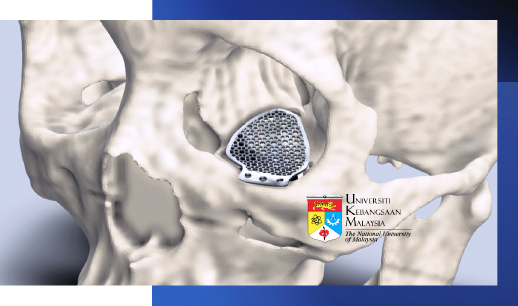
A 3D-printed custom metal facial implant for a patient
He has since done more surgeries using this method in collaboration with 3D Gens, a local 3D printing company that uses 3D printers to manufacture metal implants based on detailed digital designs.
“It was very expensive to do this. Even getting the insurance company to cover the procedure was difficult. But we managed to do it and, until today, the patients are still doing all right,” says Dr Mohd Nazimi.
In the healthcare industry, 3D printing is a tool under the umbrella of computer-assisted surgery, where technology is used to increase the precision of procedures, reduce errors and support personalised healthcare.
3D printing can be used to make customised implants for patients based on scans of their body parts. Custom 3D-printed prosthetics made from metal or plastic are already available.
“For instance, if I have to cut the patient’s jaw by half, I can use scan data from the other half of the jaw [and replicate it through 3D printing]. For patients who lose their noses [because of cancer], we can scan the real nose of the patient before the surgery and 3D print an exact replica of the nose,” says Dr Mohd Nazimi.
A more customised solution could prevent the need for repeated surgeries. It is also critical for areas of the body where a second surgery could be damaging.
“Repeated surgeries are expensive … In addition, injuries such as orbital fractures are small but it’s [important to deal with them properly] because it will be difficult to do a second surgery. It’s a very confined area that is difficult to see. That’s why the first surgery has to be precise,” he says.
This technology is also useful in producing realistic 3D models for surgical planning and training. For instance, 3D anatomy models are printed based on a patient’s MRI scan so that surgeons can plan and practise a complex surgical operation beforehand.
“While it used to be dangerous to separate Siamese twins, it’s less so now. Neurosurgeons can 3D print models of the babies’ skulls and know where the big blood vessels are, for instance,” says Dr Mohd Nazimi.
“That’s why I embarked on this journey, even though it isn’t easy. But this is the trend now, where we are talking about the Industrial Revolution 4.0. All these developments can improve surgical outcomes for patients.”
Wanted: Designers and funds
The manufacturing of medical devices has to be done in sterile conditions and meet regulatory requirements. A printer used for other objects, for instance, cannot be used to print medical implants.
The design of implants are highly detailed. “For temporary implants, it’s not as difficult. For those that we implant permanently into the patient, however, the design has to be perfect,” says Dr Mohd Nazimi.
Owing to the novelty and complexity of 3D-printed medical implants, it has not been easy for him. It is also an uphill task for those who use 3D printing — who are usually engineers by training — to communicate with the doctors.
“We have to worry about how we can transfer data without revealing the patient’s identity. There are many safety issues to consider and regulations to follow. We also need approval from insurers and others,” he says.
As there is a lack of local talent that can work with him to design these implants,
Dr Mohd Nazimi currently works with a company in Thailand for this purpose.
Most importantly, however, 3D printing of implants is still very costly. An off-the-shelf implant costs three times less than a 3D-printed one, he says. It also costs quite a bit to get the implants approved by the authorities.
“This kind of service is very routine in countries such as Germany. I’m hoping to bring it here even for primary repair surgeries, so we can assemble the implant quickly in a week or two and more patients can benefit from this technology,” he says.
He thought of creating a special interest group with experts from various specialties and a foundation to help patients who need this kind of surgical protocols.
More collaboration between players in the medical industry would be helpful too. Surgeons must be able to access data quickly, even if it is across states. Dedicated 3D printers should also be available at some central locations and easily accessible.
“It seems to be exclusive, but it isn’t. It’s the patient’s right to get the best,” Dr Mohd Nazimi says.
Save by subscribing to us for your print and/or digital copy.
P/S: The Edge is also available on Apple's AppStore and Androids' Google Play.
